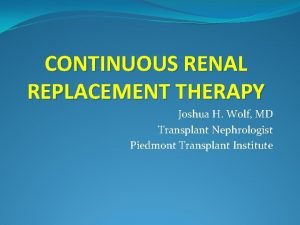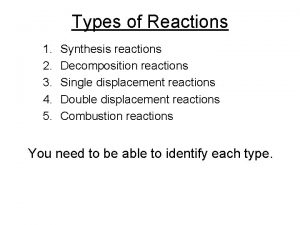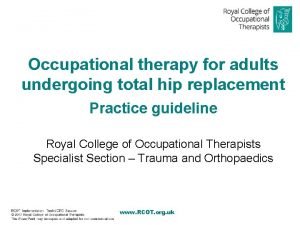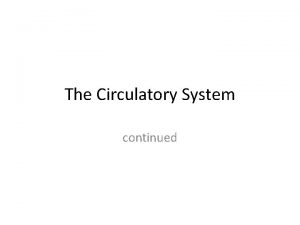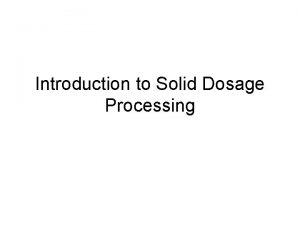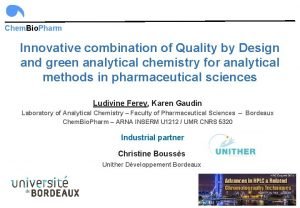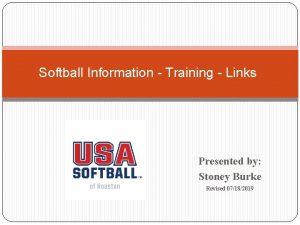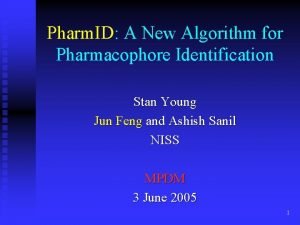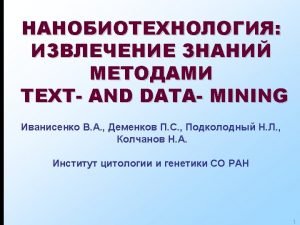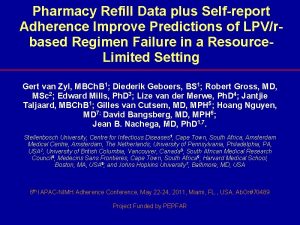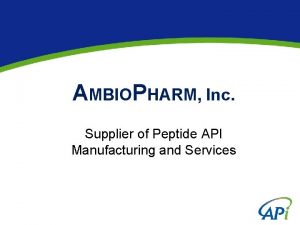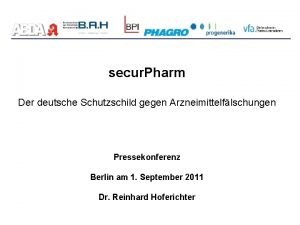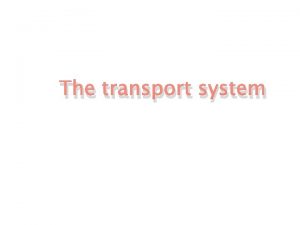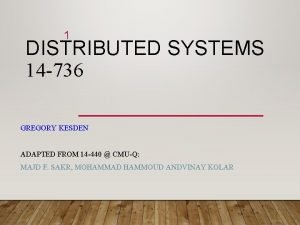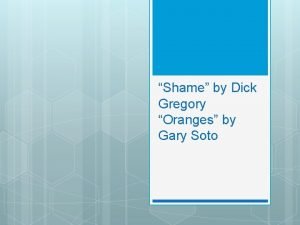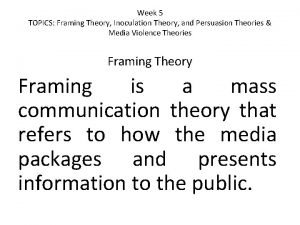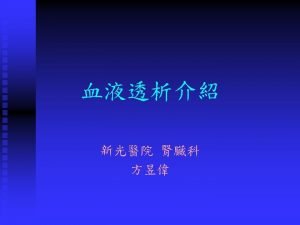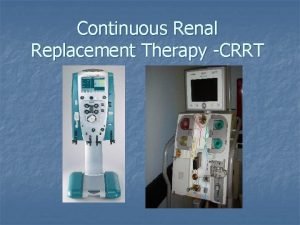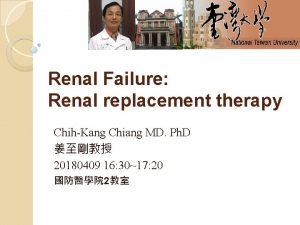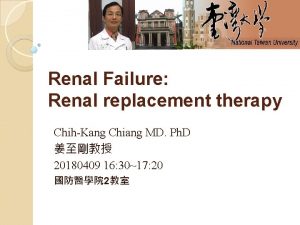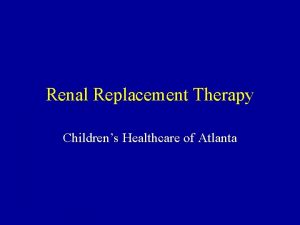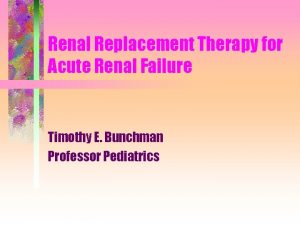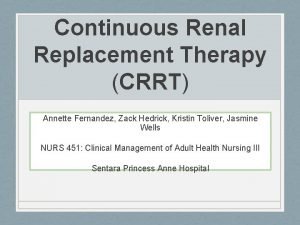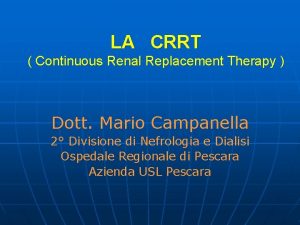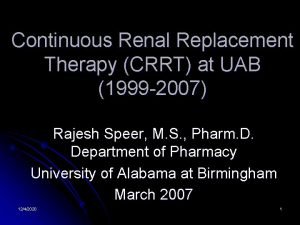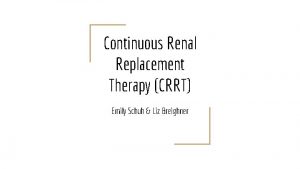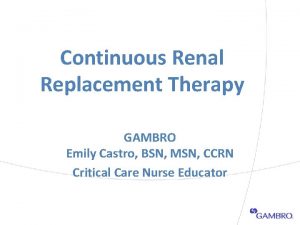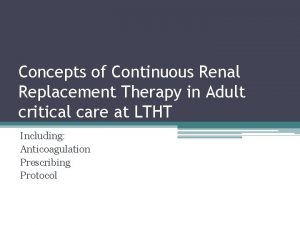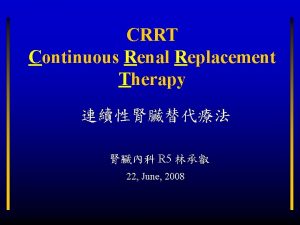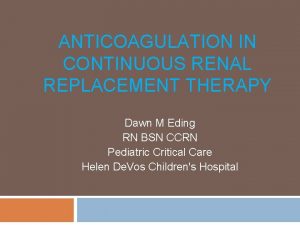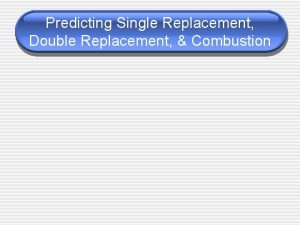Continuous Renal Replacement Therapy Gregory M Susla Pharm
































- Slides: 32

Continuous Renal Replacement Therapy Gregory M. Susla, Pharm. D. , F. C. C. M. Associate Director, Medical Information Med. Immune, Inc. Gaithersburg, MD

Definition of Terms • SCUF - Slow Continuous Ultrafiltration • CAVH - Continuous Arteriovenous Hemofiltration • CAVH-D - Continuous Arteriovenous Hemofiltration with Dialysis • CVVH - Continuous Venovenous Hemofiltration • CVVH-D - Continuous Venovenous Hemofiltration with Dialysis

Indications for Continuous Renal Replacement Therapy • Remove excess fluid because of fluid overload • Clinical need to administer fluid to someone who is oliguric – Nutrition solution – Antibiotics – Vasoactive substances – Blood products – Other parenteral medications

Advantages of Continuous Renal Replacement Therapy • Hemodynamic stability – Avoid hypotension complicating hemodialysis – Avoid swings in intravascular volume • Easy to regulate fluid volume – Volume removal is continuous – Adjust fluid removal rate on an hourly basis • Customize replacement solutions • Lack of need of specialized support staff

Disadvantages of Continuous Renal Replacement Therapy • Lack of rapid fluid and solute removal – GFR equivalent of 5 - 20 ml/min – Limited role in overdose setting • Filter clotting – Take down the entire system

Basic Principles • Blood passes down one side of a highly permeable membrane • Water and solute pass across the membrane – Solutes up to 20, 000 daltons • Drugs & electrolytes • Infuse replacement solution with physiologic concentrations of electrolytes

Anatomy of a Hemofilter blood in Cross Section hollow fiber membrane dialysate out Outside the Fiber dialysate in (effluent) Inside the Fiber blood out (blood)

Basic Principles • Hemofiltration – Convection based on a pressure gradient – ‘Transmembrane pressure gradient’ • Difference between plasma oncotic pressure and hydrostatic pressure • Dialysis – Diffusion based on a concentration gradient

CVVH Continuous Veno-Venous Hemofiltration to waste Blood In (from patient) Repl. Solution Blood Out (to patient) LOW PRESS HIGH PRESS (Convection)

CVVH Continuous VV Hemofiltration • Primary therapeutic goal: – Convective solute removal – Management of intravascular volume • Blood Flow rate = 10 - 180 ml/min • UF rate ranges 6 - 50 L/24 h (> 500 ml/h) • Requires replacement solution to drive convection • No dialysate

CVVH Performance Continuous venous hemofiltration “In vitro” ultrafiltration with blood (post-dilution) (values ± 15%) (Bovine blood at 37 C, Hct 32%, Cp 60 g/l)

CVVHDF Continuous Veno-Venous Hemodiafiltration to waste Blood In (from patient) Dialysate Solution Repl. Solution Blood Out (to patient) LOW PRESS LOW CONC HIGH PRESS HIGH CONC (Convection) (Diffusion)

CVVHDF Continuous VV Hemodiafiltration • Primary therapeutic goal: – Solute removal by diffusion and convection – Management of intravascular volume • Blood Flow rate = 10 - 180 ml/min • Combines CVVH and CVVHD therapies • UF rate ranges 12 - 24 L/24 h (> 500 ml/h) • Dialysate Flow rate = 15 - 45 ml/min (~1 - 3 L/h) • Uses both dialysate (1 L/h) and replacement fluid (500 ml/h)

Pharmacokinetics of Continuous Renal Replacement Therapy

Basic Principles • Extracorporeal clearance (Cl. EC) is usually considered clinically significant only if its contribution to total body clearance exceeds 25 - 30% Fr. EC = Cl. EC / Cl. EC + Cl. R + Cl. NR • Not relevant for drugs with high non-renal clearance • Only drug not bound to plasma proteins can be removed by extracorporeal procedures

Determinants of Drug Removal by CRRT • Drug • Membrane Same as hemodialysis but increased MW range Permeability Sieving Coefficient • Renal replacement Cl technique Convection + diffusion Flow rates Blood, Dialysate, UF Duration of CRRT

Sieving Coefficient (S) • The capacity of a drug to pass through the hemofilter membrane S = Cuf / Cp Cuf = drug concentration in the ultrafiltrate Cp = drug concentration in the plasma S=1 Solute freely passes through the filter S=0 Solute does not pass through the filter CLHF = Qf x S

Determinants of Sieving Coefficient • Protein binding – Only unbound drug passes through the filter • Protein binding changes in critical illness • Drug membrane interactions – Not clinically relevant • Adsorption of proteins and blood products onto filter – Related to filter age – Decreased efficiency of filter

Relationship Between Free Fraction (fu) and Sieving Coefficient (SC) SC

Dialysate Saturation (Sd) • Countercurrent dialysate flow (10 - 30 ml/min) is always less than blood flow (100 - 200 ml/min) • Allows complete equilibrium between blood serum and dialysate • Dialysate leaving filter will be 100% saturated with easily diffusible solutes • Diffusive clearance will equal dialysate flow

Dialysate Saturation (Sd) S d = Cd / C p Cd = drug concentration in the dialysate Cp = drug concentration in the plasma • Decreasing dialysate saturation – Increasing molecular weight • Decreases speed of diffusion – Increasing dialysate flow rate • Decreases time available for diffusion Cl. HD = Qd x Sd

CVVHDF Clearance Continuous venous hemofiltration - post dilution QB = 150 ml/min - QD = 2000 ml/h (in vitro saline)

Extracorporeal Clearance • Hemofiltration clearance (Cl. HF = Qf x S) Qf = Ultrafiltration rate S = Seiving coefficient • Hemodialysis clearance (Cl. HD = Qd x Sd) Qd = Dialysate flow rate Sd = Dialysate saturation • Hemodialfiltration clearance Cl. HDF = (Qf x S) + (Qd x Sd)

Case History • AP 36 yo HM s/p BMT for aplastic anemia • Admitted to ICU for management of acute renal failure • CVVH-D initiated for management of uremia • ICU course complicated by pulmonary failure requiring mechanical ventilation, liver failure secondary to GVHD and VOD, and sepsis

Case History Antibiotic Management on CRRT • Gentamicin 180 mg IV q 24 h • Vancomycin 1 g IV q 24 h • Dialysis rate 1000 ml/hour – 12 hour post gentamicin levels: 3 - 4 mg/L – 12 hour post vancomycin levels: 20 - 23 mg/L • Dialysis rate increased to 1200 ml/hour – 12 hour post gentamicin levels: < 0. 4 mg/L – 12 hour post vancomycin levels: < 4 mg/L

Dosage Adjustments in CRRT • Will the drug be removed? – Pharmacokinetic parameters • Protein binding < 70 - 80% – Normal values may not apply to critically ill patients • Volume of distribution < 1 L/kg • Renal clearance > 35% • How often do I dose the drug? – Hemofiltration: ‘GFR’ 10 - 20 ml/min – Hemofiltration with dialysis: ‘GFR’ 20 - 50 ml/min

Drug Removal During CRRT • • Recommendations not listed in PDR Limited to case reports or series of patients Different filter brands, sizes, flow rates Limited information in many reports – Rarely report % of dose removed • Many journals will not publish case reports • Artificial models and predictions have no clinical value

Dosage Adjustments in CRRT • Loading doses – Do not need to be adjusted – Loading dose depends solely on volume of distribution • Maintenance doses – Standard reference tables – Base on measured loses – Calculate maintenance dose multiplication factor (MDMF)

Dosage Adjustments in CRRT • Frequent blood level determinations – Aminoglycosides, vancomycin • Reference tables – Bennett's tables or the PDR recommendations require an approximation of patient's GFR – The CVVH ‘GFR’ is approximated by the ultrafiltrate (UFR), plus any residual renal clearance – Using Bennett's or the PDR’s tables, in most CVVH patients, drug dosing can be adjusted for a ‘GFR’ in the range of 10 to 50 ml/min

Supplemental Dose Based on Measured Plasma Level

Adjusted Dose Based on Clearance Estimates

COMPARISON OF DRUG REMOVAL BY INTERMITTENT HD AND CRRT
 Res extra commercium
Res extra commercium Sindrome nefrótica
Sindrome nefrótica Rrt aeiou
Rrt aeiou Renal corpuscle
Renal corpuscle Na o cl
Na o cl Occupational therapy hip replacement interventions
Occupational therapy hip replacement interventions Nicotine replacement therapy side effects
Nicotine replacement therapy side effects Major physiological anions
Major physiological anions Pharm 406
Pharm 406 Nicole noel purdue
Nicole noel purdue Library.med.utah.edu/kw/pharm/hyper heart.html
Library.med.utah.edu/kw/pharm/hyper heart.html Solid blender
Solid blender Bc bio-pharm
Bc bio-pharm Forensic pharmacist
Forensic pharmacist Outfield pharm
Outfield pharm Pharm id
Pharm id Pharm gkb
Pharm gkb Epharmacy
Epharmacy Pharm
Pharm Pharm d means
Pharm d means Peptide api manufacturers
Peptide api manufacturers Secur pharm
Secur pharm What is the transport system of the body
What is the transport system of the body Klucel exf pharm
Klucel exf pharm Future past progressive
Future past progressive Present simple present continuous past simple
Present simple present continuous past simple Psychoanalytic therapy is to as humanistic therapy is to
Psychoanalytic therapy is to as humanistic therapy is to Psychodynamic and humanistic therapies have in common
Psychodynamic and humanistic therapies have in common Bioness integrated therapy system price
Bioness integrated therapy system price Dr greg bernstein
Dr greg bernstein Gregory kesden
Gregory kesden Shame dick gregory
Shame dick gregory Second level agenda setting
Second level agenda setting


